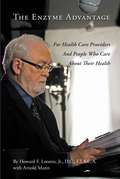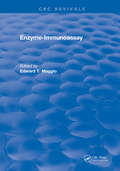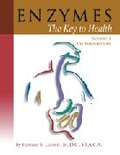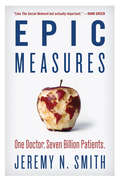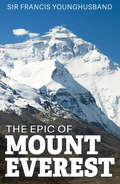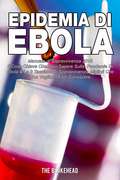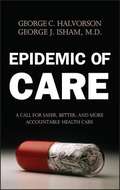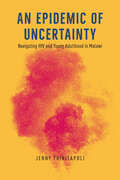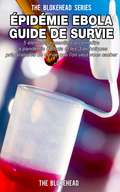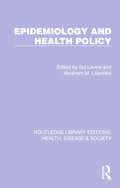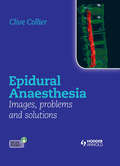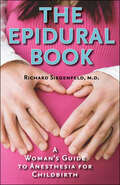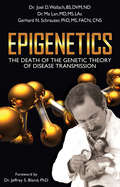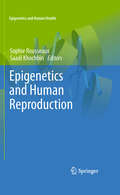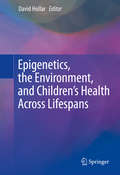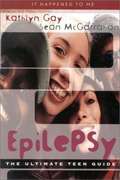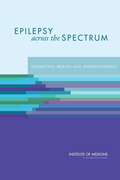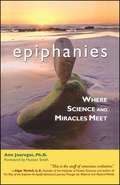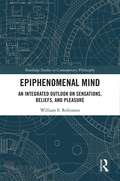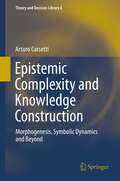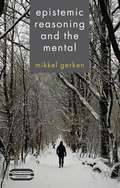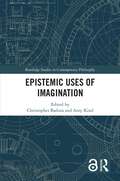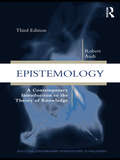- Table View
- List View
The Enzyme Advantage: For Health Care Providers And People Who Care About Their Health, First Edition
by Howard F. Loomis Arnold MannThe book answers the question:'why we need enzyme'. The Enzyme Advantage is a resource book for all health care providers and people who care about their health.
Enzyme Immunoassay
by Edward T. MaggioThe purpose of this book is to focus attention on some of these ideas and concepts. In doing so, it has captured a glimpse of the past and it attempts a projection of the future, but mostly it reveals an overview of the field as it exists as the present time. It aims to serve to spawn further growth in ideas and encourage applications to increasingly broader segments of both clinical and general analytical chemistry fields.
Enzyme Nutrition
by Edward HowellWhy is eating food in its natural state, unprocessed and unrefined, so vital to the maintenance of good health? What is lacking in our modern diet that makes us so susceptible to degenerative disease? What natural elements in food may play a key role in unlocking the secrets of life extension? These fascinating questions, and many more, are answered in Enzyme Nutrition. Written by one of America's pioneering biochemists and nutrition researchers, Dr. Edward Howell, Enzyme Nutrition presents the most vital nutritional discovery since that of vitamins and minerals--food enzymes. Our digestive organs produce some enzymes internally, however food enzymes are necessary for optimal health and must come from uncooked foods such as fresh fruits and vegetables, raw sprouted grains, unpasteurized dairy products, and food enzyme supplements. Enzyme Nutrition represents more than fifty years of research and experimentation by Dr. Howell. He shows us how to conserve our enzymes and maintain internal balance. As the body regains its strength and vigor, its capacity to maintain its normal weight, fight disease, and heal itself is enhanced.
Enzymes: Volume 1 : The Fundamentals
by Howard F. Loomis“My goal in writing this book is to present an easy-to-understand explanation for considering the role naturally occurring food enzymes can play in our lives. This book will present a simple system, if you will, of understanding how our bodies work and the role that enzymes play in keeping us healthy. I will try to show you when and why your body develops symptoms, and the role diet and digestion play in their appearance. I will also try to show you why two people eating the same diet, for example, you and your spouse or other family member, may not develop the same problems. In other words, I will help you to obtain something I call nutritional objectivity and use it to prevent disease and maintain health.” – by the author.
Epic Measures: One Doctor. Seven Billion Patients.
by Jeremy N. SmithMoneyball meets medicine in this remarkable chronicle of one of the greatest scientific quests of our time and the visionary mastermind behind it.Medical doctor and economist Christopher Murray began the Global Burden of Disease study to gain a truer understanding of how we live and how we die. While it is one of the largest scientific projects ever attempted—as breathtaking as the first moon landing or the Human Genome Project—the questions it answers are meaningful for every one of us: What are the world's health problems? Who do they hurt? How much? Where? Why?Murray argues that the ideal existence isn't simply the longest, but the one lived well and with the least illness. Until we can accurately measure global health issues, we cannot understand what makes us sick or do much to improve it. Challenging the accepted wisdom of the WHO and the UN, the charismatic and controversial health maverick has made enemies—as well as some influential friends, including Bill Gates who gave Murray a $100 million grant.Told with novelistic verve by acclaimed journalist Jeremy N. Smith, the story of Murray's lifelong determination to understand how we live and die encompasses wars and famines, presidents and activists, billionaires and billions of people worldwide living in poverty. It shows the human side of scientific revolutions and of revolutionary scientists—their breakthroughs and setbacks, their genius and their flaws, their champions and their critics—as they strive to bring the news of their findings to the world. This transformational effort is far from over, but the story of its genesis and impact is already an epic tale.
The Epic of Mount Everest: The Historic Account Of Mallory's Expeditions
by Sir Francis YounghusbandThe Epic of Mount Everest, first published in 1926, is the exciting story of the first attempts to reach the summit of Mount Everest, including that of George Mallory and Andrew Irvine, who disappeared and died in the 1924 expedition. Considered “must reading” for mountaineers, The Epic of Mount Everest provides a fascinating insight into the men, methods, and struggles of early mountain-climbers. Included are 15 pages of illustrations and 2 maps.
Epidemia di Ebola Manuale di Sopravvivenza 2015
by The BlokeheadQuando arrivano resoconti sul virus dell'ebola, molte persone diventano estremamente timorose del fatto che il Paese stia realmente avendo a che fare con un'epidemia di ebola quando invece si parla soltanto di alcuni casi isolati. A dire la verità, molte persone hanno paura che una pandemia di ebola sia dietro l'angolo. Di conseguenza, le persone stanno praticamente percorrendo ogni strada possibile per scoprire più informazioni possibili su ciò che dovrebbero fare per proteggere loro stesse e le persone a loro care. Questo manuale di sopravvivenza contro l'ebola in sette parti può aiutarti ad imparare ciò di cui hai bisogno sulla malattia e su cosa fare per proteggere te stesso e la tua famiglia.
Epidemic of Care: A Call for Safer, Better, and More Accountable Health Care
by George C. Halvorson George J. IshamRecognizing a crisis in American health care, but rejecting any solutions that are not "market-based," Halvorson (chair and CEO, Kaiser Permanente) and Isham (chief health officer, HealthPartners) explore some of the reasons for rising health care costs (absolving the HMOs for any responsibility) and make suggestions for improving the situation. Their proposed system rests largely on promoting evidence- based care for physicians and transferring greater costs to patients to improve "efficiency."
An Epidemic of Uncertainty: Navigating HIV and Young Adulthood in Malawi
by Jenny TrinitapoliA decade-long study of young adulthood in Malawi that demonstrates the impact of widespread HIV status uncertainty, laying bare the sociological implications of what is not known. An Epidemic of Uncertainty advances a new framework for studying social life by emphasizing something social scientists routinely omit from their theories, models, and measures–what people know they don’t know. Taking Malawi’s ongoing AIDS epidemic as an entry point, Jenny Trinitapoli shows that despite admirable declines in new HIV infections and AIDS-related mortality, an epidemic of uncertainty persists; at any given point in time, fully half of Malawian young adults don’t know their HIV status. Reckoning with the impact of this uncertainty within the bustling trading town of Balaka, Trinitapoli argues that HIV-related uncertainty is measurable, pervasive, and impervious to biomedical solutions, with consequences that expand into multiple domains of life, including relationship stability, fertility, and health. Over the duration of a groundbreaking decade-long longitudinal study, rich survey data and poignant ethnographic vignettes vividly depict how individual lives and population patterns unfold against the backdrop of an ever-evolving epidemic. Even as HIV is transformed from a progressive, fatal disease to a chronic and manageable condition, the accompanying epidemic of uncertainty remains fundamental to understanding social life in this part of the world. Insisting that known unknowns can and should be integrated into social-scientific models of human behavior, An Epidemic of Uncertainty treats uncertainty as an enduring aspect, a central feature, and a powerful force in everyday life.
Épidémie Ebola Guide de survie
by The BlokeheadGuide de survie du virus Ebola/Ebola Outbreak Survival Guide 5 key things you need to know about the Ebola Pandemic
Epidemiology and Health Policy (Routledge Library Editions: Health, Disease and Society #18)
by Sol Levine Abraham LilienfeldOriginally published in 1987, this book examines the priorities of health policy in the late 20th Century and the varied approaches or strategies to foster the prevention or control of disease. Several chapters focus on specific diseases and conditions, but other areas of concern such as injuries, alcoholism, drug-abuse, occupational health and nutrition are also dealt with. The book illuminates how epidemiology can serve as a more effective basis for health policy and practice and will be of great value to students and lecturers of medical sociology, epidemiological medicine and health policy.
Epidural Anaesthesia: Images, Problems and Solutions
by Clive CollierEpidural Anaesthesia: Images, Problems and Solutions brings together the most comprehensive collection of post-block epidurograms in the world into a single volume. With accompanying X-rays and contrast injection images, it clearly explains why an epidural block has failed and provides practical advice on how to avoid complications in the future.Ke
The Epidural Book: A Woman's Guide to Anesthesia for Childbirth
by Richard SiegenfeldAddresses concerns, confusion, and misinformation about epidurals and other childbirth anesthesia.The majority of women giving birth in the United States receive an epidural during labor and delivery; many others receive a spinal block. The Epidural Book fully explains anesthesia used during labor and vaginal delivery or C-section, with an emphasis on epidurals. Dr. Richard Siegenfeld answers pregnant women's questions, including • Who administers epidurals and spinal blocks and when?• How does anesthesia affect both the mother and the baby?• Under what circumstances should a woman avoid an epidural?• What happens during the recovery period?• What problems can arise?Written by an experienced anesthesiologist, The Epidural Book is lighthearted and informative. This easy-to-read guide helps an expectant mother prepare for her all-important day.
Epigenetics: The Death of the Genetic Theory of Disease Transmission
by Gerhard N. Schrauzer Jeffrey S. Bland Ma Lan Joel D. WallachWHAT IS EPIGENETICS? Epigenetics is an emerging field of science that studies alterations in gene expression caused by factors other than changes in the DNA sequence. Epigenetics: The Death of the Genetic Theory of Disease Transmission is the result of decades of research and its findings that could be as critical to our understanding of human health as Pasteur's research in bacteriology. Dr. Joel "Doc" Wallach has dedicated his life work to identifying connections between certain nutritional deficiencies and a range of maladies, formerly thought to be hereditary, including Cystic Fibrosis and Muscular Dystrophy. This nexus between nutrition and so-called genetic disease has been observed in both humans and primates, and it is the central theme of Epigenetics. To bring us Epigenetics, Wallach has teamed with noted scholars Dr. Ma Lan and Dr. Gerhard N. Schrauzer. Their collective expertise gives this book its far reaching perspective. Epigenetics is of vital importance to anyone who wants real knowledge about how the human body functions, and it provides a path for better health. Epigentics dispels the dogma and misinformation propagated by medical institutions and doctors resistant to change. Epigenetics is the beginning of a new era of well-being on this planet.
Epigenetics and Human Reproduction
by Saadi Khochbin Sophie RousseauxEpigenetics is a rapidly expanding field in medical and biological research which concerns heritable traits that are not attributable to changes in the DNA sequence. Epigenetic mechanisms play key roles in many biological processes, and it has become clear that their disruption can gives rise to diverse pathologies in humans. Edited by preeminent experts, Sophie Rousseaux and Saadi Khochbin, this volume in the 'Epigenetics and Human Health' series discusses the role of epigenetics in human reproduction
Epigenetics, the Environment, and Children's Health Across Lifespans
by David HollarThis stimulating volume addresses vital questions about gene/environment interactions as they affect cell health from the prenatal period through later life. Beginning with a tour of epigenetic processes in the human body, the book assembles current theoretical and empirical developments across the discipline, among them transgenerational epigenetic inheritance, the effects of maternal nutrition on epigenetic change, and possible links between epigenetics and childhood obesity. Public health and policy aspects of the field are discussed in depth, with the understanding that much can be done to improve our epigenetic health as a species. And in this vein, contributors consider future possibilities, such as the reprogramming of genes to reverse cancer and other diseases. Included in the coverage: The role of environmental epigenetics in perinatal and neonatal development The epigenetic biomarker γH2AX: from bench science to clinical trials What's the risk? Dental amalgam, mercury exposure, and human health risks throughout the lifespan Post-traumatic stress disorder: neurological, genetic, and epigenetic bases Children's exposure to alcohol, tobacco, and drugs: long-term outcomes Ethical implications of epigenetics Epigenetics, the Environment, and Children's Health Across Lifespans brings real-world knowledge and applications of this increasingly important field to public health practitioners, maternal and child health researchers, and environmental health experts.
Epilepsy: The Ultimate Teen Guide
by Kathlyn Gay Sean McgarrahanEpilepsy: The Ultimate Teen Guide dispels the myths, misconceptions, and misunderstandings about epilepsy and the people who have the disorder. It provides factual medical information and advice for teens on how to live a normal life. Stories from teens who have epilepsy show readers they can participate in normal activities. They also offer advice on whether and how to tell friends, dates, teachers, or an employer about the condition. This book concludes with an extensive list of publications, websites, and organizations, as well as an appendix that covers the Americans with Disabilities Act and how it applies to people who have epilepsy.
Epilepsy Across the Spectrum
by Committee on the Public Health Dimensions of the EpilepsiesAlthough epilepsy is one of the nation's most common neurological disorders, public understanding of it is limited. Many people do not know the causes of epilepsy or what they should do if they see someone having a seizure. Epilepsy is a complex spectrum of disorders that affects an estimated 2. 2 million Americans in a variety of ways, and is characterized by unpredictable seizures that differ in type, cause, and severity. Yet living with epilepsy is about much more than just seizures; the disorder is often defined in practical terms, such as challenges in school, uncertainties about social situations and employment, limitations on driving, and questions about independent living. The Institute of Medicine was asked to examine the public health dimensions of the epilepsies, focusing on public health surveillance and data collection; population and public health research; health policy, health care, and human services; and education for people with the disorder and their families, health care providers, and the public. In Epilepsy Across the Spectrum, the IOM makes recommendations ranging from the expansion of collaborative epilepsy surveillance efforts, to the coordination of public awareness efforts, to the engagement of people with epilepsy and their families in education, dissemination, and advocacy for improved care and services. Taking action across multiple dimensions will improve the lives of people with epilepsy and their families. The realistic, feasible, and action-oriented recommendations in this report can help enable short- and long-term improvements for people with epilepsy. For all epilepsy organizations and advocates, local, state, and federal agencies, researchers, health care professionals, people with epilepsy, as well as the public, Epilepsy Across the Spectrum is an essential resource.
The Epilepsy Prescriber's Guide to Antiepileptic Drugs
by Philip N. Patsalos Blaise F.D. BourgeoisThis practical and concise book is an essential reference guide for use by all clinicians and allied health professionals that treat or care for patients with epilepsy. In full color throughout, this volume presents the antiepileptic drugs (AEDs), 34 in total, in alphabetical order and for each AED the information is divided into eight colored sections: general therapeutics, pharmacokinetics, interaction profile, adverse effects, dosing and use, special populations, overview, and suggested reading. This second edition has been extensively revised and updated. Specific additions include: • inclusion of the new drugs perampanel and retigabine (also called ezogabine) • updated pharmacokinetic interactions • suggested pediatric dosing schedules for several drugs • discussion about bone health, and vitamin D monitoring and supplementation • information on teratogenicity in the sections on pregnancy. This handy pocket book will be an excellent companion for all clinicians that treat patients with epilepsy.
Epiphanies: Where Science and Miracles Meet
by Huston Smith Ann JaureguiIn a quiet moment of therapy, a breakthrough comes -- the miracle of the new. To experience an epiphany is to have sudden insight into the essential meaning of something, unleashed sometimes in exquisitely slow motion, sometimes in a flash. In an intimate, lyrical integration of the science of psychology and transcendence of spirituality, celebrated clinician Dr. Ann Jauregui introduces us to nine individuals who have undergone astonishing transformations by exploring a world quite different from the one described by our five senses. With moments of miraculous and joyful surprise, Epiphanies exposes a reality outside of everyday existence that has momentous implications for life's ultimate questions. "Shyly we venture out with these stories," Dr. Jauregui writes, "into a world where science itself is struggling to describe a realm out of time and space and language." We are the beneficiaries of these extraordinary shifts of perspective, invited into a sparkling conversation that allows us to see the potential residing in all of us.
Epiphenomenal Mind: An Integrated Outlook on Sensations, Beliefs, and Pleasure (Routledge Studies in Contemporary Philosophy)
by William S. RobinsonAccording to epiphenomenalism, our behavior is caused by events in our brains that also cause our mentality. This resulting mentality reflects our brains’ organization, but does not in turn cause anything. This book defends an epiphenomenalist account of philosophy of mind. It builds on the author’s previous work by moving beyond a discussion of sensations to apply an epiphenomenalist outlook to other aspects of mental causation such as beliefs, desires, pleasure, and displeasure. The first four chapters of the book argue for a dualistic theory of sensations and develop an epiphenomenalist version of dualism. The remaining chapters discuss propositional attitudes and valence. The author also responds to potential objections to epiphenomenalism by considering how sensations, intelligence, or understanding might be built into a robot. This book will be of interest to scholars and students in philosophy of mind who are interested in consciousness, mental causation, and how our mentality is situated in the world.
Epistemic Complexity and Knowledge Construction
by A. CarsettiThe volume as its first target aims at clarifying that peculiar entanglement of complexity, causality, meaning, emergence and intentionality that characterises the unfolding of the "natural forms" of human cognition As is well known, cognition is not only a self-organising process. It is also a co-operative and coupled process. If we consider the external environment as a complex, multiple and stratified Source which interacts with the nervous system, we can easily realise that the cognitive activities devoted to the "intelligent" search for the depth information living in the Source, may determine the very change of the complexity conditions according to which the Source progressively expresses its "wild" action. In this sense, simulation models are not neutral or purely speculative: the true cognition actually appears to be necessarily connected with successful forms of reading, those forms, in particular, that permit a specific coherent unfolding of the deep information content of the Source. Therefore, the simulation models, if valid, materialise as "creative" channels, i.e., as autonomous functional systems, as the very roots of a new possible development of the entire system represented by mind and its Reality. From a general point of view, the objectivity of Reality is also proportionate to the autonomy reached by cognitive processes. In this sense, at the level of cultural evolution, reference procedures act as guide, mirror and canalisation with respect to primary information flows and involved selective forces: they offer themselves as the actual instruments for the constant renewal of the code, for the invention and the actual articulation of an ever-new incompressibility. From an effective point of view, they appear as indissolubly linked to the successive definition of specific (and innovative) measures of the epistemic complexity. These measures cannot concern only statistical rarity (Shannon) or computational incompressibility (Kolmogorov-Chaitin), on the contrary they should also be able to take into account the coupled connection between the Source and the cognitive agent, the evolution of this connection as well as the successive constitution of meaning as symbolic form. Hence the possible (and necessary) definition of new axiomatic systems, new measure spaces, the real displaying of processes of continuous reorganisation at the semantic level. Indeed, it is only through a complete, first-order "reduction" and a correlated non-standard second-order analysis that new incompressibility will actually manifest itself. Therefore, the reference procedures appear to be related to a process of multiplication of minds, as well as to a process of "clarification" of meanings which finally emerges as vision via principles.
Epistemic Reasoning And The Mental
by Mikkel GerkenEpistemic Reasoning and the Mental integrates the epistemology of reasoning and philosophy of mind. The book contains introductions to basic concepts in the epistemology of inference and to important aspects of the philosophy of mind. By examining the fundamental competencies involved in reasoning, Gerken argues that reasoning's epistemic force depends on the external environment in ways that are both surprising and epistemologically important. For example, Gerken argues that purportedly deductive reasoning that exhibits the fallacy of equivocation may nevertheless transmit epistemic warrant from its premise-beliefs to its conclusion-belief. This view is contrary to orthodoxy according to which such reasoning must be valid. But Gerken shows how this novel and unorthodox view is integrated in a psychologically plausible account of our reasoning competencies and a general epistemological framework. What emerges is an approach to the philosophy of reasoning that is informed and constrained by both epistemology and philosophy of mind.
Epistemic Uses of Imagination (Routledge Studies in Contemporary Philosophy)
by Helen Donaghue Christopher BaduraThis book explores a topic that has recently become the subject of increased philosophical interest: how can imagination be put to epistemic use? Though imagination has long been invoked in contexts of modal knowledge, in recent years philosophers have begun to explore its capacity to play an epistemic role in a variety of other contexts as well. In this collection, the contributors address an assortment of issues relating to epistemic uses of imagination, and in particular, they take up the ways in which our imaginings must be constrained so as to justify beliefs and give rise to knowledge. These constraints are explored across several different contexts in which imagination is appealed to for justification, namely reasoning, modality and modal knowledge, thought experiments, and knowledge of self and others. Taken as a whole, the contributions in this volume break new ground in explicating when and how imagination can be epistemically useful. Epistemic Uses of Imagination will be of interest to scholars and advanced students who are working on imagination, as well as those working more broadly in epistemology, aesthetics, and philosophy of mind.
Epistemology: A Contemporary Introduction to the Theory of Knowledge (3rd Edition)
by Robert AudiEpistemology, or “the theory of knowledge,” is concerned with how we know what we know, what justifies us in believing what we believe, and what standards of evidence we should use in seeking truths about the world and human experience. This comprehensive introduction to the field of epistemology explains the concepts and theories central to understanding knowledge. Along with covering the traditional topics of the discipline in detail, Epistemology explores emerging areas of research. The third edition features new sections on such topics as the nature of intuition, the skeptical challenge of rational disagreement, and “the value problem” – the range of questions concerning why knowledge and justified true belief have value beyond that of merely true belief. Updated and expanded, Epistemology remains a superb introduction to one of the most fundamental fields of philosophy. Special features of the third edition of Epistemology include: a comprehensive survey of basic concepts, major theories, and emerging research in the field enhanced treatment of key topics such as contextualism, perception (including perceptual content), scientific hypotheses, self-evidence and the a priori, testimony, understanding, and virtue epistemology expanded discussion of the relation between epistemology and related fields, especially philosophy of mind, philosophy of science, and ethics increased clarity and ease of understanding for an undergraduate audience an updated list of key literature and annotated bibliography.
